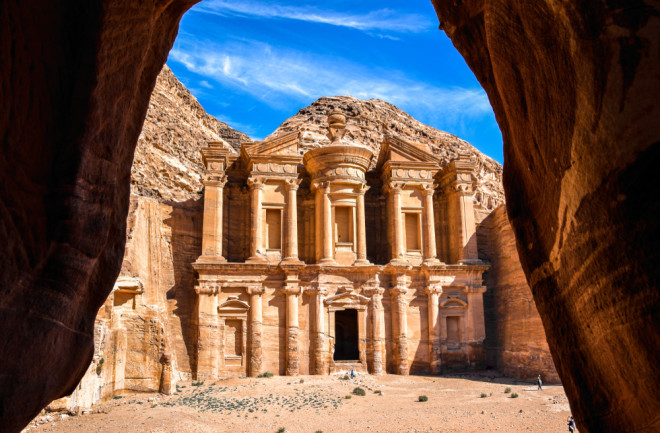The Nabataean Kingdom was an influential ancient civilization located in the northwestern part of the Arabian Peninsula, covering parts of modern-day Jordan, Syria, Saudi Arabia, and Israel. The Nabataeans are renowned for their remarkable achievements in trade, architecture, and engineering. Their capital, Petra, is one of the most iconic archaeological sites from the ancient world.
Historical Context
Origins and Development
- Early Beginnings: The Nabataean people are believed to have originated from the southern Arabian Peninsula and migrated to the north around the 4th century BCE. They established themselves in the region that would become their kingdom, gradually developing a complex and sophisticated society.
- Rise to Power: By the 1st century BCE, the Nabataeans had consolidated their power and established a prosperous kingdom. Their strategic location along major trade routes enabled them to become key players in regional commerce.
Economic and Trade Influence
Trade Networks
- Trade Routes: The Nabataeans controlled crucial trade routes that connected the Arabian Peninsula with the Mediterranean world. Their kingdom was a central hub in the incense trade, dealing in goods such as frankincense, myrrh, spices, and textiles.
- Economic Prosperity: The wealth generated from trade allowed the Nabataeans to develop a flourishing economy. They established a network of caravan cities and trading posts that facilitated the movement of goods and contributed to their economic success.
Engineering and Infrastructure
- Water Management: The Nabataeans are renowned for their advanced engineering skills, particularly in water management. They constructed complex systems of cisterns, aqueducts, and channels to collect and distribute water in the arid desert environment, enabling them to sustain large populations.
- Urban Planning: The Nabataean capital of Petra is a prime example of their urban planning expertise. The city was carved into the rose-red cliffs of the Petra valley and featured intricate rock-cut architecture, including temples, tombs, and administrative buildings.
Cultural and Religious Aspects
Religion and Beliefs
- Polytheistic Religion: The Nabataeans practiced a polytheistic religion with a pantheon of deities. Key deities included Dushara (the chief god), Al-Uzza (a goddess of fertility), and Atargatis (a goddess associated with water and fertility). Temples and shrines dedicated to these deities were prominent features of Nabataean cities.
- Religious Practices: Religious rituals and ceremonies played an important role in Nabataean society. The Nabataeans built elaborate temples and conducted various rites to honor their gods and ensure the prosperity of their kingdom.
Language and Writing
- Script and Inscriptions: The Nabataeans used a script derived from the Aramaic alphabet. Nabataean inscriptions, which include religious texts, administrative documents, and commemorative inscriptions, provide valuable insights into their language, culture, and society.
- Cultural Influence: The Nabataean script influenced the development of other scripts in the region, including the Arabic script. Their language and writing system were integral to their administrative and cultural practices.
Political Structure and Governance
Monarchical System
- Kings and Rulers: The Nabataean Kingdom was ruled by a series of kings, with the most notable being Aretas IV (reigned 9 BCE – 40 CE), who is known for expanding the kingdom and enhancing its prosperity. The kings held significant power and were central to the kingdom’s political and economic life.
- Administrative Organization: The Nabataeans maintained a sophisticated administrative system that managed trade, taxation, and urban planning. Their ability to govern effectively contributed to the stability and success of their kingdom.
Diplomacy and Relations
- Foreign Relations: The Nabataeans engaged in diplomacy with neighboring states, including the Roman Empire, the Ptolemaic Kingdom of Egypt, and various Arab tribes. They often used diplomatic alliances and marriage arrangements to secure their interests and maintain stability.
- Roman Influence: In the early 2nd century CE, the Nabataean Kingdom came under Roman influence. Petra was annexed by the Roman Empire in 106 CE, becoming the province of Arabia Petraea. Despite this, the Nabataeans continued to exert cultural and economic influence under Roman rule.

Decline and Legacy
Decline
- Roman Annexation: The annexation of the Nabataean Kingdom by the Roman Empire marked the beginning of its decline as an independent state. The city of Petra continued to thrive as a Roman provincial capital but gradually lost its prominence due to shifting trade routes and economic changes.
- Changes in Trade Routes: The decline of the Nabataean trade networks, coupled with changes in trade routes and the rise of new powers in the region, contributed to the gradual decline of Petra and the loss of Nabataean influence.
Legacy
- Architectural and Cultural Heritage: The Nabataeans left a lasting legacy through their architectural and engineering achievements. Petra, with its rock-cut structures and advanced water management systems, remains one of the most significant archaeological sites in the world and a UNESCO World Heritage Site.
- Influence on Later Cultures: The Nabataean language and script influenced the development of Arabic and other writing systems. Their contributions to trade, architecture, and urban planning have been studied extensively and continue to impact historical and archaeological research.
The Nabataean Kingdom was a vibrant and influential civilization that played a key role in the history of the Arabian Peninsula. Its achievements in trade, engineering, and culture have left an enduring legacy that continues to fascinate and inspire scholars and visitors alike.









